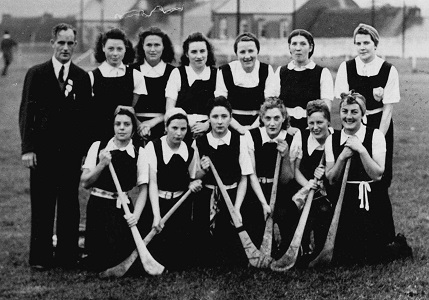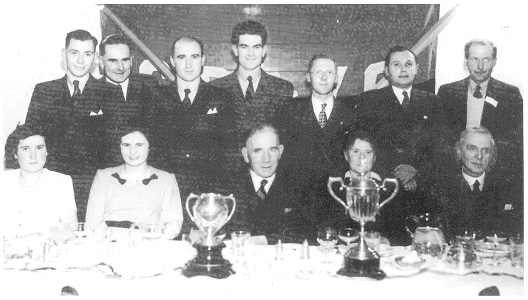Old Galway
SIOBHÁN McKENNA

by Tom Kenny
Siobhán Giollamhuire McKenna was born on May 24th, 1922, a second daughter to Eoghan McKenna and Gretta O’Reilly, Nancy being her older sister. She was educated in Belfast, in Taylor’s Hill Convent and then after a year out sick with glandular fever, as a boarder in St. Louis Convent, Monaghan.
Her family moved to Galway in 1928 when her father was made a lecturer in Mathematics in UCG. They lived in Fort Eyre in Shantalla and only spoke Irish at home. She played out on the street with her friends, cycled up and down Red Lane, annoyed couples who were courting in the bushes and became great friends with an old man across the road she knew as ‘Gongy’ . Siobhán was a very good camogie player. She graduated from college with a first class honours B.A. in 1943 and then did a post-grad course in French in UCD.
GALWAY’S TRIUMPH IN THE 1923 FINAL

by Tom Kenny
This game was not actually played until September 1924 when Galway faced Limerick in a ‘dour hour’s hurling’. “Physical strength, fitness and courage were the dominating factors. The play was strenuous if fitful and an exciting period followed the interval when Limerick made determined efforts to wipe off the arrears. Galway finished with great dash and were clearly superior on the day’s form”. These were the words of P.D. Mehigan who reported on the game for the Irish Times.
“McKenepick, Dublin, refereed and he had rather a busy time, for the game was robust and vigorous from the outset. Limerick had a strong wind behind them from the city goal and Gleeson opened the scoring for them with a clever point from the side line. They continued to press but the Munster forwards were wayward in their shooting, ball after ball being sent wide.
GALWAY POSTBOXES

by Tom Kenny
The regular use of the words “post” and “Litir” in 15th century Irish manuscripts suggests that by that time, a postal system was already in existence here. In 1657, a Bill was passed ‘for settling the postage of England, Scotland and Ireland’ which set up a Government monopoly of the service. The Galway Post Office had been established in 1653, and the network of Post Offices throughout the county gradually grew.
With the rapid growth of correspondence following the introduction of uniform penny postage in 1840, a demand for more posting locations arose and the public began to request more roadside posting facilities. France had already successfully established a system of postboxes but there was a nervousness about installing them in Ireland as the public were unsure of their security.
REMEMBERING MAURICE SEMPLE

by Tom Kenny
Maurice Semple was born in 1917, a member of a family that had continuous connection with the ‘Citie of the Tribes’ for over 400 years, one of three children of Frank Semple and Elizabeth ffrench. His father worked in a clerical capacity in the courthouse, his mother was one of the ffrenchs from Claregalway. Both his brother ffrench Semple and his sister Mary predeceased him.
Maurice became an apprentice solicitor with St. John Blake and then set up his own practice with Kieron Murphy in Eglinton Street in the late 1960s. The practice eventually moved to Courthouse Square where it was joined by Una Fleming. It became very successful even though it was often said of Maurice that he was too nice to be a solicitor. He was a kind and generous man who treated clients like friends. A spiritual man, he was a daily mass-goer in the Jesuit church every morning. Indeed, his friendship with the community there meant he was occasionally referred to as “The co-rector of the Jesuits”. He was blessed by his marriage to Grace Kelly from Long Walk.
THE CHANGING FACE OF KINGSHILL

by Tom Kenny
Our first photograph today (courtesy of the National Library) is a bird’s eye view that was taken in 1953 and shows the Warwick Hotel at the top of the picture. Next to it on the right was the entrance to Lenaboy Park, and beyond that you can see part of Queeney’s shop. Next door was Doorley’s private house and then Mrs. Turke’s B&B called Osterley Lodge. Opposite, on the far side of the road was Billy Binn’s house and on the corner, as you can see, was a field with a lot of trees, much used as a playground by local children. This whole area was very prone to flooding and was occasionally rendered impassable as was the case with Hurricane Debbie.
On the near side of the road you can see part of the Galway Bay Hotel still under construction. It was being built by the Miss McDonaghs who owned St. Theresa’s Nursing Home a few doors away. They intended this building as a nursing home but their budget overran and they had to abandon the project. The building was eventually taken over by a building society and they sold it to Jack and Olive Smith. Jack’s brother George helped to convert it from a nursing home to a hotel and it opened as The Galway Bay Hotel in 1956.
TRAFFIC CHANGES IN GALWAY

by Tom Kenny
When the city was being constructed in medieval times, the streets and even the lanes must have appeared wide and spacious. The only kind of traffic they would have experienced then would have been pedestrian, horse or donkey and cart and maybe the odd wheelbarrow. We have two images for you today of the east side of Eyre Square the first (courtesy the National Library) dates from c.1890 and shows that type of traffic; The second (courtesy Galway County Library) shows the same area with motorised traffic. Since the latter was taken, the population has grown by 6 or 7 times, and of course, the traffic volumes have increased accordingly. So the Corporation had to make occasional changes to the bye-laws in relation to traffic.
On April 1st, 1963, a new thirty mile per hour speed limit for the city and the built up areas around it was introduced ‘for the well-being of the people’. It would affect all the main roads except part of the Oranmore Road near Merlin Park.
GALWAY SIMON COMMUNITY

by Tom Kenny
In October 1979, two psychology students, Margaret Brehony and Kathy O’Grady teamed up with a philosophy student, Conall Mac Riocard and formed a group of volunteers. They started a twice weekly soup run to people who were sleeping rough in Galway. They made the soup and sandwiches at home and then they would do the run. They only met one person on their first night, but gradually, the numbers increased. They found that the experience of squeezing into a car, then picking one’s way over rubble, broken glass or perhaps rats, to a man lying in a corner, probably open to the sky, gave them an inescapable motivation to work towards the goal of a night shelter in Galway.
At the time, one of their clients slept in a pigsty opposite the Presentation Primary School, some in a railway siding near Lough Atalia, some in skips, in the bathing shelters on the prom, in a rat-infested cottage on Frenchman’s Lane, in cardboard boxes, one young man slept in a disused telephone box that had fallen down at Ballyloughane Beach and was suffering from pneumonia when they found him. In another case, they had to climb over an eight-foot fence in dark undergrowth behind the Claddagh Palace.
THE SCHOLARS OF ‘73

by Tom Kenny
What memories do you have of your schooldays? Here are some reminiscences of a few old ‘Jes-mugs’,
Seán Duignan recalls that “To tell the truth, back in the late 1940’s and early fifties, being condemned to ‘six of the best’ was not all that bad. Back then too, we were part of a ‘boys only’ set-up, wearing little peaked caps which we doffed while saluting with military precision whenever a cassock or a clerical collar hove into view. We spoke Irish at all times – being caught speaking English was a punishable offence – and Gaelic football, hurling, handball and rowing were the only acceptable sporting activities. ‘Foreign games such as rugby and God forbid, soccer were beyond the pale”.
Dick Byrne’s memories are musical –“Musically, we had a great time in the Jes, and it planted the love of singing and theatre in me that was to continue all my life”.
